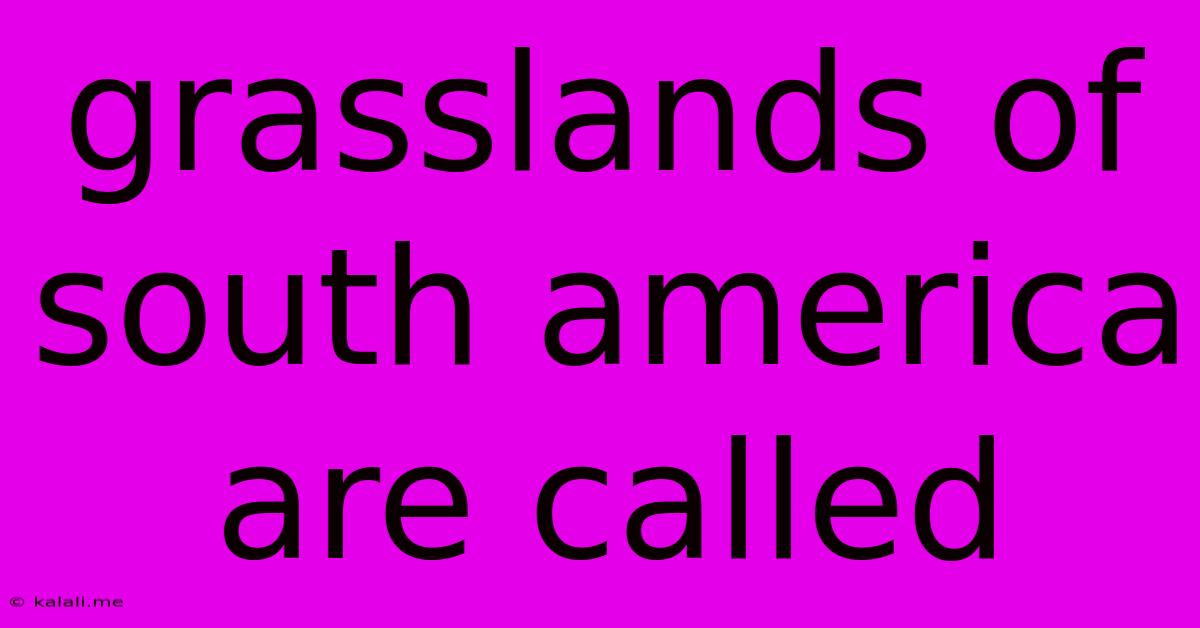Grasslands Of South America Are Called
Kalali
Jun 15, 2025 · 3 min read

Table of Contents
South American Grasslands: A Deep Dive into the Pampas, Llanos, and Cerrado
South America boasts some of the world's most expansive and diverse grasslands, each with unique characteristics and ecological significance. While the term "grasslands" is a broad categorization, several distinct regions dominate the South American landscape. Understanding these different ecosystems is key to appreciating the continent's biodiversity and the challenges facing its conservation. This article will explore the major South American grasslands, focusing on the Pampas, Llanos, and Cerrado.
Keywords: South American grasslands, Pampas, Llanos, Cerrado, grassland ecosystems, biodiversity, South American ecology, flora, fauna, conservation
The term "grasslands of South America are called" is too broad. South America has several distinct grassland ecosystems, each with its own unique name and characteristics. Let's dive into the three most prominent:
1. The Pampas: Argentina's Fertile Heartland
The Pampas, predominantly located in Argentina, are arguably the most well-known South American grasslands. Characterized by their incredibly fertile soil, these vast plains support extensive agriculture, making them a crucial part of Argentina's economy. The Pampas ecosystem supports a rich biodiversity, encompassing a wide array of grasses, wildflowers, and various grazing animals. However, intensive farming practices have impacted the native flora and fauna, emphasizing the importance of sustainable land management strategies. Think cattle ranching, wheat farming, and the iconic image of the gaucho, the South American cowboy, when picturing the Pampas.
2. The Llanos: Venezuela and Colombia's Floodplains
Spanning across Venezuela and Colombia, the Llanos are characterized by their seasonal flooding patterns. During the wet season, these plains transform into vast, watery expanses, supporting a unique ecosystem adapted to fluctuating water levels. The dry season reveals a more traditional grassland landscape, perfect for grazing animals. The Llanos are home to a remarkable array of wildlife, including capybaras, caimans, and diverse bird species. The seasonal inundation is a key feature influencing the flora and fauna of this region. Unlike the Pampas, the Llanos are more susceptible to changes in rainfall patterns, highlighting the vulnerability of these ecosystems to climate change.
3. The Cerrado: Brazil's Savanna Jewel
Unlike the Pampas and Llanos, the Cerrado is a savanna ecosystem, characterized by a mix of grasslands and woodland vegetation. Located primarily in Brazil, it is one of the most biodiverse savannas globally, housing a wealth of endemic plant and animal species. The Cerrado's unique biodiversity is under increasing threat due to deforestation and agricultural expansion. The Cerrado's rich soil is attractive for agriculture, especially for soybean and cattle farming. Conservation efforts are crucial to preserving this exceptional ecosystem and its incredible biodiversity.
Conclusion: Preserving South America's Grassland Heritage
The Pampas, Llanos, and Cerrado represent only a fraction of South America’s grassland ecosystems. Each region presents unique ecological challenges and opportunities. Understanding these distinct environments is crucial for effective conservation and sustainable land management practices. Balancing agricultural needs with biodiversity conservation is a key challenge facing these vital ecosystems. Further research and collaborative efforts are vital to ensure the long-term health and preservation of South America's remarkable grasslands for future generations.
Latest Posts
Latest Posts
-
Charge Of Alpha Particle In Coulombs
Jun 15, 2025
-
1 Calorie Is Equal To How Many Joules
Jun 15, 2025
-
The Earth Receives Energy From The Sun By
Jun 15, 2025
-
Which Of The Following Is A Consequence Of Biological Magnification
Jun 15, 2025
-
A Is Not Greater Than B
Jun 15, 2025
Related Post
Thank you for visiting our website which covers about Grasslands Of South America Are Called . We hope the information provided has been useful to you. Feel free to contact us if you have any questions or need further assistance. See you next time and don't miss to bookmark.